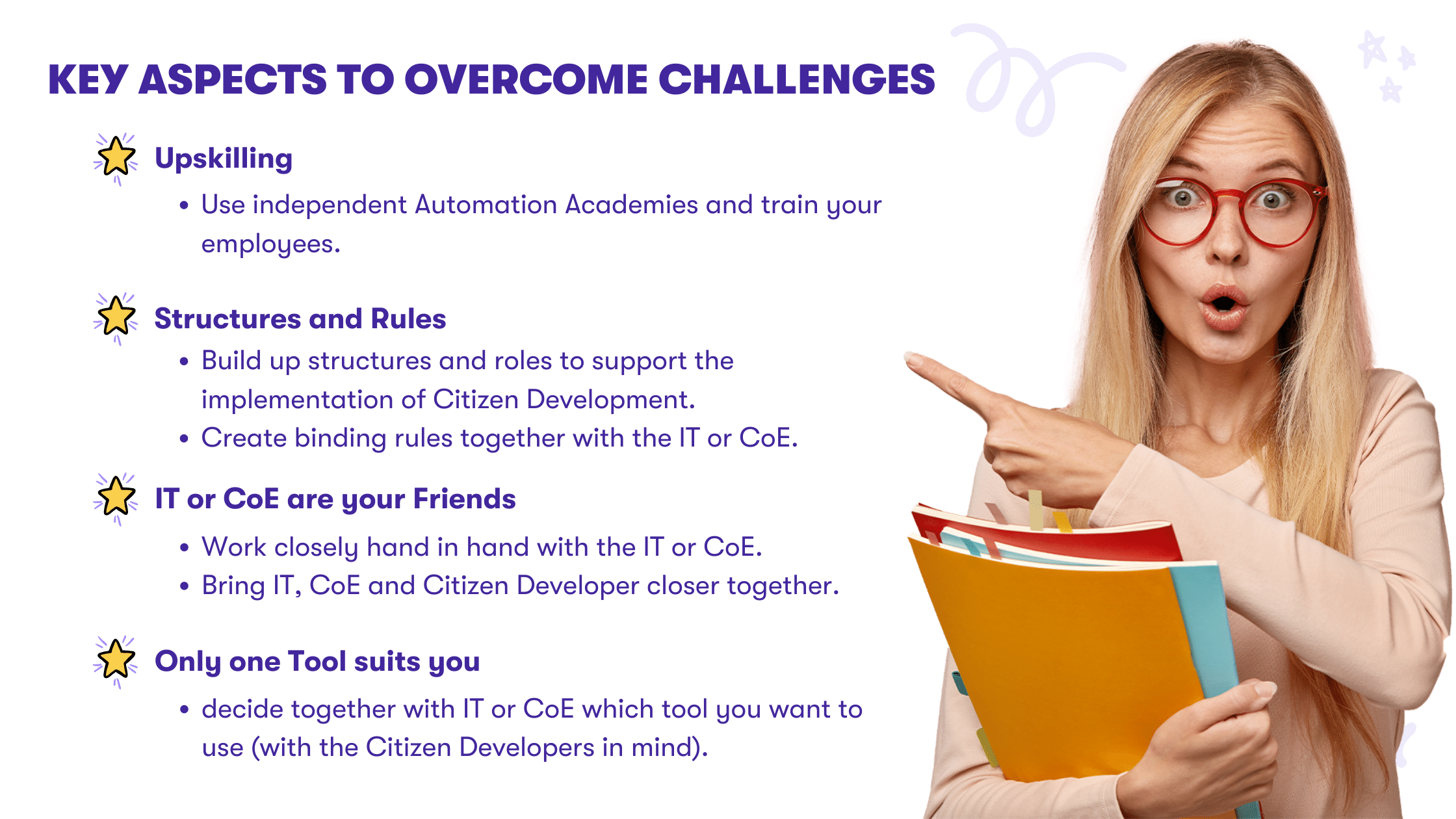Citizen development is one of the most important aspects in any automation strategy. It helps organizations to meet their goals by using a combination of low code and no code tools, frameworks and services to make it easier for developers to build software apps for the business.
By 2023, there will be four times as many citizen developers working in large corporations as traditional programmers, predicts Gartner. Additionally, programs for citizen development are already in place at almost 40% of the businesses examined. Additionally, 20% of those who don't are researching them.
What is Citizen Development?
The term citizen development is used to describe giving non-developers the ability to create software apps.
The theory behind it is that it empowers people to solve problems, create business applications and automate tasks without needing to know how to code. This fast-lane application development can lead to more innovation and better customer service in the business.
The term is often used in contrast to professional app development, which refers to software development carried out by highly specialized developers.
The Key Pillars of Citizen Development
The citizen developer model needs a solid foundation with essential components in place in order to succeed. The three pillars that this framework's execution depends on are
- people,
- processes,
- and technology.
.png)
People
The right people must be involved in citizen development. In order for the citizen development program to be successful, a citizen developer collaborate with practice managers, coaches, and professional developers.
Roles and duties for each person engaged must be clearly defined for there to be an effective collaboration platform. Fostering community platforms that encourages ongoing learning, enabling, and long-term growth is crucial.
Processes
The right procedure ensures that sofware solutions are delivered consistently. It makes ensuring that citizen developers follow the rules for reporting, testing, and maintenance. The scope of the app must be established and these standards must be made explicit.
Technology
The success depends on the proper technology deployment, software platform and correct use of data. It must enhance and supplement a development program's people and process pillars. It must establish a development environment that encourages cooperation, upholds compliance, data security and generates profit for the whole business.
A business must use technology that integrates with internal procedures, data and governance frameworks to develop software apps for intelligent workflows. The no or low code technology must be simple to use and reuse for both citizen developers and business IT.
The Benefits of Citizen Development
Citizen Development combines the best of both worlds - the agility and flexibility of Agile and the rigor and discipline of Waterfall.
It is about improving the experience for customers, employees and partners alike. Therefore reducing the friction in the relationship between your business and stakeholders.
There are even more advantages to incorporating citizen development into your overall automation strategy.
Contribution and Augmentation
It can help you tap into a wider pool of potential contributors since (almost) anyone with an interest and motivation can learn the skills needed. This helps to augment the developers shortage a business normally faces.
Collaboration and Innovation
Citizen development can help promote collaboration and innovation, as users are able to share their ideas, data and feedback directly with developers.
Empowerement and Relief
Citizen development is a bottom-up approach that empowers business users to develop their own application without involving IT via a no or low code platform. This helps to reduce their never-ending backlog and IT can focus on deeper architectural concerns of the business.
Flexibility an Agility
Finally, citizen development can lead to faster and more flexible development cycles, as no or low code applications can be built and updated more quickly in response to user needs. In short, citizen development is a powerful tool for promoting collaboration, innovation, and flexibility in the company.
.png)
The challenges of citizen development
Citizen Development is a rather new concept that presents many companies and their Chiefs of Automation (COA) or Automation Leads with significant challenges before the automation gold can be recovered.
Here is a list of the most common ones:
Lack of Expertise
Companies oftentimes underestimate the required skillset employees need to have, to become successfull citizen developers.
Experience has shown that the lack of expertise on the emplyoee level is one of the main reasons for the failure.
A more detailed list of what an untrained citizen developer lacks:
Logical Expertise
Normatizing data is one of the things that citizen developers frequently overlook based on their lack of logical expertise. They may not be aware of the benefits of encapsulating repeatable functionality into functions and rules, leading them to repeat a great deal of procedural labor.
Discipline Expertise
It is also important to have discipline competence in the sense of subject matter knowledge. For instance, understanding which data sets are required is just as crucial as understanding how to query them. Understanding the effects of parallel activity in workflow scenarios, as well as whether two or more items are actually independent of one another or whether there is some implicit expectation of sequence that has never been recorded, is far from simple.
Method Expertise
Rather than tools or algorithms, this is primarily about processes and project management in a business. It covers practices like iterative development cycles, putting apps through development-testing-production stages, and delivery rings for testing new features among a smaller user base before releasing them to progressively wider audiences. Unless their creations become well-known, untrained citizen developers should typically stay away from this kind of stuff.
Tool Expertise
This speaks to the ability to recognize the best instruments for dealing with various issues in a business. Without being aware of this, citizen developers frequently try to solve every problem with the same no or low code platform. Most of the time, even though the technology makes it possible to avoid writing code like developers, it doesn't take away the necessity to think like one.
Lack of Organization
Another equally important aspect of why many companies fail to creat high value out of citizen development is the lack of organizational structure to provide an orderly framework for this powerful tool.
The Lack of Organization on a higher level includes several parts that need special consideration by leads:
No Consistency
From an organizational standpoint, once citizen development is adopted, this isn't just about one but multiple applications. There could be two, five, twenty, fifty, or even hundreds of apps — each app radically different from the others.
Users hate inconsistent behavior. It also makes new business applications a one-off job with no capacity to draw on earlier work, hinders uptake, and raises training expenses. That makes management absolutely insane. In the end, it makes maintaining the application much more difficult, if not impossible, for anyone who is not the author.
Missing Roles and Responsibilities
Citizen Development is a new aspect of an organization's overall automation strategy. There are not yet best practices that can be easily copied for every business or business unit.
Not every company needs a Chief Citizen Developer or a Center of Excellence, but those responsible must first create structures with fixed roles and responsibilites that fit into their organizational structure and data security.
UiPath uses a four-level role system for this dilemma, which works with different access rights and permissions:
.png)
Lack of Rules and Norms
Despite its significance, citizen development does have some risks, particularly when improper management is employed. Without sound governance, citizen development can lead to software and data flaws, IT vulnerabilities, and other problems of a similar nature.
For a Citizen Development initiative to function, it is critical to establish rules and norms. Topics like cyber security, governance, compliance or other areas need to be monitored.
However, most companies fail to establish a governance body or committee that monitors these important factors.
No Metrics for Success
The organization oftentimes do not define their evaluation criteria for business success. This is important for measuring impact and future growth of citizen development efforts.
The following are some examples showing the success of a low code initiative:
- Return on invest (ROI)
- benchmarks for digital transformation
- the volume of IT requests
- sources of stress
Too much Focus on Software rather than People
Companies and their leads like to invest rather in software licenses than in the people and tend to view Citizen Development from a too tech-focused standpoint.
This relates to the lack of expertise on the side of the aspiring citizen developers. They are often neglected in the course of tool selection and the associated skills required, even though they are the ones who are ultimately supposed to automate and build apps with them.
Overcome the Challenges of Citizen Development
Introducing Citizen Development into a company's automation strategy is no walk in the park. It requires planning, time and perseverance.
To survive these challenges, every company and its decision makers should take the following points to heart:
Knowledge is Key
Citizen Development doesn't mean just putting an employee at a no or low code tool and business success will be garantued. To be successful, it is important to transfer knowledge to all stakeholders involved - from ordinary employees to leads and above.
At the beginning of the journey, the focus should first be on people. After selecting suitable future citizen developers, they must be equipped with the necessary skillset to use a low code platform to build a working app (see above).
It is important to note that leads should also undergo further training in terms of management and providing clear structures. Also some experience with the used platforms is benefitial.
For this purpose, there are a number of provider-independent academies (like the Automation Academy from Bots & People or VisualMakers) that have experience with the required knowledge of citizen developers and leads.
Other options would be avery specific training that tool providers like UiPath for their particular tool offer or community building within the company.
In the case of the former, the in-house offering unfortunately runs counter to the general learning aspirations of a business.
Community building can be combined with both, but is unfortunately very vulnerable when carried out alone, as the community often falls when important people leave and is generally difficult to control because of the voluntary factor.
Read more about Citizen Development Training.
Clear Structures and Rules
Clear structures, roles and responsibilities are an important part of the implementation of citizen development in the company-wide strategy. Without this, all the knowledge built up sinks into the depths of chaos.
Chum up with IT (or CoE)
Initiatives for citizen development can only be successful if IT and business work together. They must coordinate their agendas and engage in open dialogue. For citizen developers to produce citizen development apps that adhere to governance requirements, IT teams must establish standards and a certain kind of platform the developers can act on.
Chose the right Tools
Creating applications can be challenging, especially for people with little experience in programming. Without the proper tools, citizen coders will frequently need assistance from IT teams. By doing this, the intention of giving basic jobs to IT teams is defeated. Therefore, the appropriate instruments must be available to support efficient citizen development.

How to Integrate Citizen Development into the Overall Automation Strategy
Citizen development can lead to silos and duplication of effort if not properly managed. That's why it's important to integrate citizen development into your overall strategy and establish working platforms everyone agreed upon.
Here are some tips on how to do that:
1. Define the business problems you want to solve in your business with these applications and involve citizen developers from the start on.
2. Set up governance standards for citizen development, so that solutions are consistent with your company's overall architecture and data and meet its quality requirements.
3. Make sure you have the right tools in place to support citizen development, including low code platforms and templates for common application types.
4. Create a plan for testing and deploying your solutions. Make sure you have a way to measure success so you can assess whether or not it is achieving its goals
5. Build a business culture of innovation that encourages everyone to experiment with new ideas and share best practices across the organization.
Conclusion
The introduction of Citizen Development brings many benefits that companies cannot afford to neglect in the future.
Unfortunately, however, it is not as easy as it sounds at first, and accordingly we did not want to convey a false image.
It is a rocky road - no question - but with the right planning, training and structures, the hidden automation champions can be uncovered. and we hope that this article helps to do that.

.png)












.png)